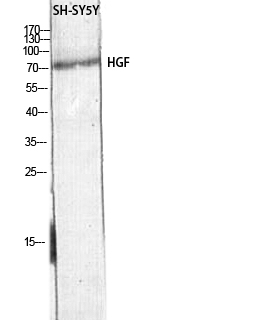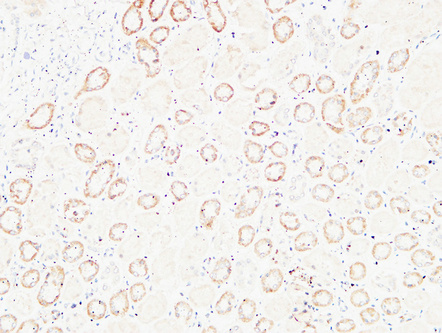HGF Polyclonal Antibody
- Catalog No.:YT5699
- Applications:WB;IHC;IF;ELISA
- Reactivity:Human;Rat;Mouse;
- Target:
- HGF
- Fields:
- >>EGFR tyrosine kinase inhibitor resistance;>>MAPK signaling pathway;>>Ras signaling pathway;>>Rap1 signaling pathway;>>Calcium signaling pathway;>>PI3K-Akt signaling pathway;>>Focal adhesion;>>Malaria;>>Pathways in cancer;>>Proteoglycans in cancer;>>Chemical carcinogenesis - reactive oxygen species;>>Renal cell carcinoma;>>Melanoma;>>Non-small cell lung cancer;>>Hepatocellular carcinoma;>>Gastric cancer
- Gene Name:
- HGF
- Protein Name:
- Hepatocyte growth factor
- Human Gene Id:
- 3082
- Human Swiss Prot No:
- P14210
- Mouse Swiss Prot No:
- Q08048
- Immunogen:
- The antiserum was produced against synthesized peptide derived from the Internal region of human HGF. AA range:500-600
- Specificity:
- HGF Polyclonal Antibody detects endogenous levels of HGF protein.
- Formulation:
- Liquid in PBS containing 50% glycerol, 0.5% BSA and 0.02% sodium azide.
- Source:
- Polyclonal, Rabbit,IgG
- Dilution:
- IHC: 100-300.WB 1:500 - 1:2000. ELISA: 1:10000.. IF 1:50-200
- Purification:
- The antibody was affinity-purified from rabbit antiserum by affinity-chromatography using epitope-specific immunogen.
- Concentration:
- 1 mg/ml
- Storage Stability:
- -15°C to -25°C/1 year(Do not lower than -25°C)
- Other Name:
- HGF;HPTA;Hepatocyte growth factor;Hepatopoietin-A;Scatter factor;SF
- Observed Band(KD):
- 80kD
- Background:
- This gene encodes a protein that binds to the hepatocyte growth factor receptor to regulate cell growth, cell motility and morphogenesis in numerous cell and tissue types. Alternative splicing results in multiple transcript variants, at least one of which encodes a preproprotein that is proteolytically processed to generate alpha and beta chains, which form the mature heterodimer. This protein is secreted by mesenchymal cells and acts as a multi-functional cytokine on cells of mainly epithelial origin. This protein also plays a role in angiogenesis, tumorogenesis, and tissue regeneration. Although the encoded protein is a member of the peptidase S1 family of serine proteases, it lacks peptidase activity. Mutations in this gene are associated with nonsyndromic hearing loss. [provided by RefSeq, Nov 2015],
- Function:
- function:HGF is a potent mitogen for mature parenchymal hepatocyte cells, seems to be an hepatotrophic factor, and acts as growth factor for a broad spectrum of tissues and cell types. It has no detectable protease activity.,online information:Hepatocyte growth factor entry,similarity:Belongs to the peptidase S1 family. Plasminogen subfamily.,similarity:Contains 1 PAN domain.,similarity:Contains 1 peptidase S1 domain.,similarity:Contains 4 kringle domains.,subunit:Dimer of an alpha chain and a beta chain linked by a disulfide bond.,
- Subcellular Location:
- extracellular region,extracellular space,membrane,platelet alpha granule lumen,
- Expression:
- Brain,Embryonic fibroblast,Leukocyte,Liver,Lung fibroblast,Placenta,
- June 19-2018
- WESTERN IMMUNOBLOTTING PROTOCOL
- June 19-2018
- IMMUNOHISTOCHEMISTRY-PARAFFIN PROTOCOL
- June 19-2018
- IMMUNOFLUORESCENCE PROTOCOL
- September 08-2020
- FLOW-CYTOMEYRT-PROTOCOL
- May 20-2022
- Cell-Based ELISA│解您多样本WB检测之困扰
- July 13-2018
- CELL-BASED-ELISA-PROTOCOL-FOR-ACETYL-PROTEIN
- July 13-2018
- CELL-BASED-ELISA-PROTOCOL-FOR-PHOSPHO-PROTEIN
- July 13-2018
- Antibody-FAQs
- Products Images

- Western blot analysis of SH-SY5Y lysis using HGF antibody. Antibody was diluted at 1:500. Secondary antibody(catalog#:RS0002) was diluted at 1:20000

- Immunohistochemical analysis of paraffin-embedded Human kidney. 1, Antibody was diluted at 1:200(4° overnight). 2, High-pressure and temperature EDTA, pH8.0 was used for antigen retrieval. 3,Secondary antibody was diluted at 1:200(room temperature, 30min).



